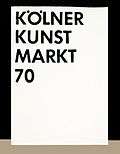Art Cologne

Art Cologne is an art fair held annually in Cologne, Germany and was established in 1967 as Kölner Kunstmarkt. It is regarded as the world's oldest art fair of its kind.[1][2] The fair runs for six days and brings together galleries from more than 20 countries at the Cologne Exhibition Center. It is open to the public and attracts about 60,000 visitors.[3]
Background
The Art Cologne was the first art fair organized by and for commercial galleries to exhibit and sell Modern and Contemporary art. This kind of art fair distinguished itself from earlier art fairs such as the 57th Street Art Fair in Chicago or the Ann Arbor Art Fairs in Michigan, in which artists themselves marketed their works directly to the public from stands set-up in the streets. The Art Cologne and other international art fairs that followed offer private galleries conditions similar to their own back home: booths in buildings enabling them to present art works of high value.
History

The Kölner Kunstmarkt was founded by galerists Hein Stünke and Rudolph Zwirner in 1967 in an attempt to reinvigorate the weak market for contemporary art. With Bonn as the new capital city of Germany, the Rhineland – an industrial powerhouse at the centre of Europe driving the West German economy and acting as a hub for the entire western European economy – took over as the centre of the West German art world. The first Kölner Kunstmarkt took place in the Gürzenich festival hall in the medieval part of the city; the following year Kunsthalle Köln was added as an additional location. The fair helped to establish Cologne as a new center of contemporary art. A West German dealer and a West German artist set new records at the 1969 edition of Kölner Kunstmarkt: René Block sold a work by Joseph Beuys – known later as Das Rudel – at DM 110,000, making Beuys the first West German artist to beat the one-hundred-thousand-mark mark.
In 1974, Art Cologne moved to its current location, the tradeshow halls at the district of Deutz. On this occasion the name was changed to Internationaler Kunstmarkt (IKM). Today's name Art Cologne was adopted in 1984. As the number of art fairs escalated, in the 2000s the fair lost exhibitors and collectors to competing events in London, Basel, Berlin and Miami.[4] With the emergence of the Berlin art scene, a bevy of remedies — special events and exhibitions, prizes and promotional gags — were devised to rejuvenate the fair, but they proved of little avail. An unattractive shift of venue within the fairgrounds and a change of dates from autumn to spring only exaggerated the unease of public and professionals alike.[5] In 2007, the fair was moved to April from the fall to avoid coinciding with other events. Still, Art Cologne drew just 60,000 visitors that year, 10,000 fewer than in 2006, and the 2008 edition had only 55,000 visitors.[6] In 2008, the fair abandoned its sister event on the Spanish island of Mallorca after just one edition and appointed Los Angeles gallery owner Daniel Hug, grandson of the Hungarian artist László Moholy-Nagy, to be its new director, part of a drive to boost attendance and win back top collectors and dealers.[7]
Format
In 2008, Art Cologne's organizers chose 150 exhibitors of which about two-thirds were German. At the 2012 edition, German galleries made up 65% of the 200 international exhibitors.[8] To meet basic costs of €35,000 for the simplest stand, a gallery owner needs sales of €200,000.[9]
ART COLOGNE Prize
The ART COLOGNE Prize is endowed with €10,000 and has been jointly awarded every year by the Bundesverband Deutscher Galerien und Kunsthändler (BVDG) (Federal Association of German Galleries and Art Dealers) and the koelnmesse since 1988.
- In 2009, the ART COLOGNE Prize went to Harald Falckenberg for making contemporary art even more accessible to a broader audience through his Falckenberg Collection.
- In 2010, the Grässlin family of collectors received the ART COLOGNE Prize for their “extraordinary merits in the promotion of modern art.”
- In 2013, the prize went to the gallery owner Fred Jahn from Munich, not least because “he combines a profound knowledge of art history and connoisseurship with the economic ambitions of an art dealer on the highest level.”
- In 2014, the prize was awarded to Rosemarie Schwarzwälder from the de:Galerie nächst St. Stephan in Vienna, in part because “her elaborate exhibitions, which could compete with any museum, are a model for presentations at major international art fairs. Her positive experiences at art fairs also inspired Rosemarie Schwarzwälder to co-initiate the Viennafair in 2005.”
See also
References
- ↑ Galloway, David (May 1, 2009). "Art Cologne Hangs On". New York Times. Retrieved September 26, 2011.
- ↑ Quinn Latimer (April 19, 2008), Reinventing the Fair Experience at Art Cologne, BLOUINARTINFO, archived from the original on 23 April 2008, retrieved May 14, 2008
- ↑ http://www.blouinartinfo.com/news/story/37333/when-in-cologne-for-art-cologne/
- ↑ Catherine Hickley (April 21, 2008), Art Cologne Sells Picasso, Warhol, Kirchner as Visitors Decline Bloomberg.
- ↑ Galloway, David (May 1, 2009). "Art Cologne Hangs On". New York Times. Retrieved September 26, 2011.
- ↑ Catherine Hickley (April 21, 2008), Art Cologne Sells Picasso, Warhol, Kirchner as Visitors Decline Bloomberg.
- ↑ L.A. dealer to head Art Cologne Los Angeles Times, March 27, 2008.
- ↑ Anna Sansom (24 April 2012), Bringing back Art Cologne The Art Newspaper.
- ↑ David Galloway (November 9, 2002), A leaner and sleeker Art Cologne New York Times.